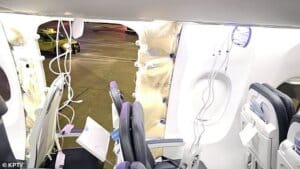ALASKA AIRLINES’ DOOR DEPARTURE CAME WITHIN 5 MINUTES OF A CATASTROPHE
ALASKA AIRLINES’ DOOR DEPARTURE CAME WITHIN 5 MINUTES OF A CATASTROPHE
 Two things by coincidence prevented loss of life. First no one was sitting in Row 24, and second the airplane was only at 16,000 feet. Five minutes more and the aircraft would have been at 24,000 feet or higher where “max diff” between cabin pressure and outside pressure would have occurred.
Two things by coincidence prevented loss of life. First no one was sitting in Row 24, and second the airplane was only at 16,000 feet. Five minutes more and the aircraft would have been at 24,000 feet or higher where “max diff” between cabin pressure and outside pressure would have occurred.
Loss of the door at that altitude or higher would have emptied the airplane of anything not strapped down and regardless row 24 would have left the airplane with any passengers seated there and maybe some other adjacent rows as well.
The NTSB is looking for the door but examination of the retaining features which are still on the airplane will reveal a lot. Examining the drawings and any production variations of that component may tell investigators if the problem is one of design, manufacture, or both.
The politics of this will be to blame it on a manufacturing error so the airplane does not stay grounded and the FAA lack of oversight gets off the hook.
The problem with this incessant stretching of a seventy-year-old design is that things like doors or emergency escape hatches keep getting relocated and its expensive to engineer structure to close the opening so a plug is used to build the airplane faster, cheaper and be able to change the configuration if required or desirable in the future. The problem is a plug is not a door. It is not as robust as a door and if it were in fact a plug it could never have left the airplane the way it did because cabin pressure would have increased its rigidity in place not blow it off the airplane.
Therefore, a serious investigation must be made of the “plug” design and it must be redesigned and certified if it turns out to be a patch instead.
The Boeing 737 went from being a 100 passenger 120,000 lb. little airplane variation of the Boeing 707, in 1963, to a behemoth carrying 225 people and weighing in at 200,000 lbs. There is a limit to stretching a design and it looks like the Max has exceeded it. Too many accidents, too many problems and the airplanes are still new. Similar capacity airliners weigh 100,000 lbs. more so where is the weight saving, structure and materials. The Max is cheap to buy and lightweight, relatively, so it is fuel efficient and airlines are falling all over themselves to buy it. They have forgotten there is no free lunch in aviation.
If nothing is found to explain the failure of the patch, then someone needs to look at how much flexing the fuselage of this extended length airplane, if any, may have contributed to this incident.
Today, it was revealed that a pressurization warning appeared several times before this flight and the airplane was restricted by Alaska Airlines from flying long flights over water. Rule Number One in aviation is that airplanes do not fix themselves. That airplane should have been grounded until the problem was found and it was fixed. Every flight exposed all those passengers to potential injury and death. That is just plain wrong. The question remaining is whether Alaska maintenance contacted Boeing technical support for a solution. I’m very concerned that restricting an airliner from flying part of its FAA certified flight envelope without FAA concurrence is even legal irrespective of how reckless it may have been.
Finally, it is reported that no data was able to be downloaded from the cockpit voice recorder. Really? That component retains the recordings for the last 2 hours of flight and maybe even more. There is a regulatory proposal to extend that to 24 hours like the rest of the world. This is odd because in years past the CVR recorded continuously the last 24 hours of cockpit discussions but for some reason the FAA allowed that to be reduced to only 2 hours.
Boeing, Alaska Airlines and the FAA should breathe a sigh of relief that no one was killed either in the air or on the ground but this lack of FAA enforcement of its own regulations and worse the NTSB’s lack of collective experience in aircraft accident investigation makes the likelihood of finding the right reason for this near catastrophe very unlikely in my experience.
Arthur Alan Wolk
January 7. 2024
Photo by Nybreaking.com

